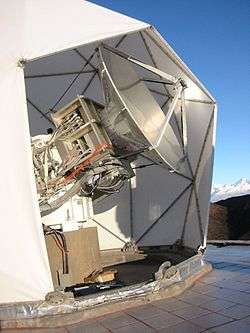Solar Submillimeter Telescope
|
The SST during a maintenance procedure with the radome open. | |
| Organisation | Argentina, Brazil |
|---|---|
| Location(s) |
Complejo Astronómico El Leoncito San Juan Province, Argentina |
| Coordinates | 31°47′56.3″S 69°17′48.1″W / 31.798972°S 69.296694°W |
| Altitude | 2,491 m |
| Telescope style | Single Dish, radome enclosed, focal array at room temperature. Frequencies: 212 GHz, 405 GHz |
| Diameter | 1.5 m |
| Website | Official SST site |
The Solar Submillimeter Telescope (SST) is a solar dedicated instrument with the aim to study the radiation produced by high energetic particles during solar flares. Observing at 212 and 405 GHz with a focal array since 2001, it is a unique instrument that has produced a wealth of new information. Some of its discoveries are still unexplained by current theories[1]. SST construction started in 1995, and it saw the first light in April 1999; since April 2001 it operates in a daily basis. It is installed at Complejo Astronomico El Leoncito (San Juan Province, Argentina) under agreement between the Argentinian National Scientific and Technical Research Council (CONICET) and the Brazilian Universidade Presbiteriana Mackenzie.
References
- ↑ Krucker; et al. (23 March 2013). "Solar flares at submillimeter wavelengths". The Astronomy and Astrophysics Review. 58,21 (1). doi:10.1007/s00159-013-0058-3. Retrieved 15 August 2014.
This article is issued from Wikipedia - version of the 3/7/2016. The text is available under the Creative Commons Attribution/Share Alike but additional terms may apply for the media files.
